Health
AI app helps aging adults manage their prescriptions with one photo: ‘Your personal health assistant’
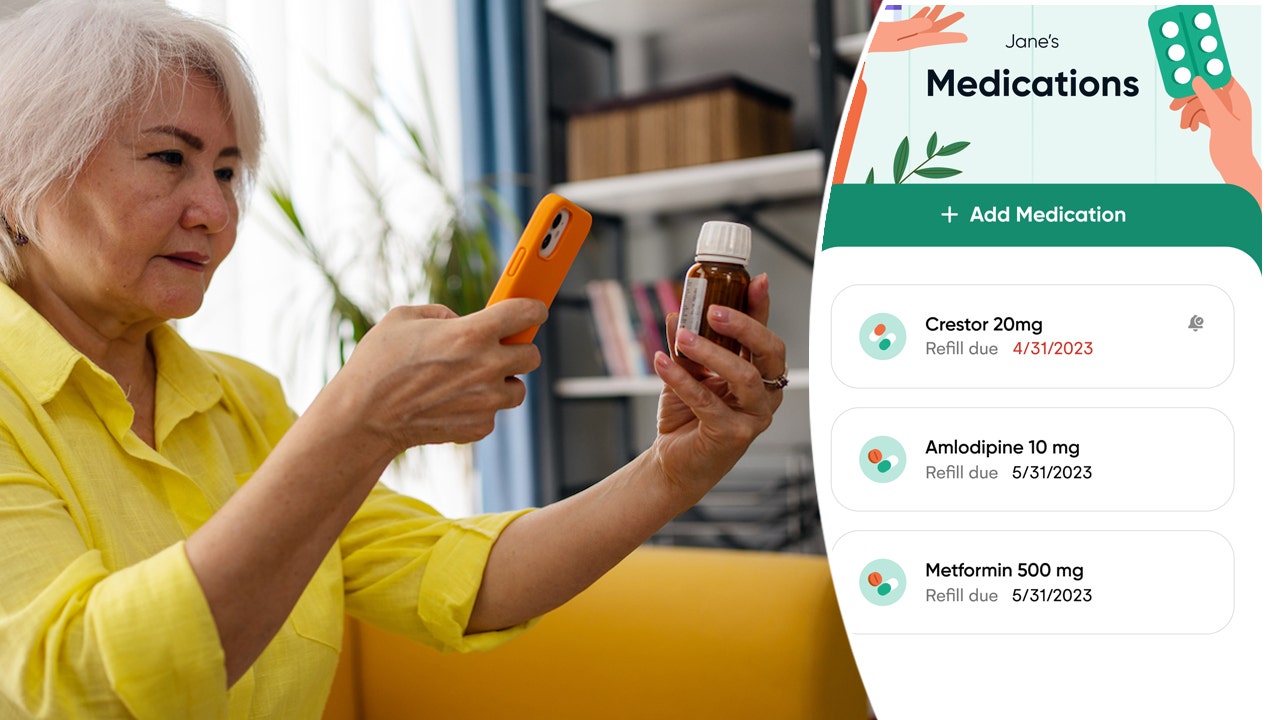
As many as 55% of older adults fail to take their prescribed medications, according to data from the Department of Health and Human Services. Now a new artificial intelligence app aims to change that.
“Together,” a free iPhone app built on generative AI, is designed to help aging adults and their caregivers manage medications and other health care tasks.
Using a smartphone camera, the person simply snaps a picture of a prescription bottle. Together’s AI technology automatically detects key information about the medication and how it pertains to that specific patient.
AI TECH AIMS TO HELP PATIENTS CATCH DISEASE EARLY, EVEN ‘REVERSE THEIR BIOLOGICAL AGE’
Dr. Renee Dua, founder and chief strategy officer of Together in Los Angeles, California, created the app after her personal experience of serving as her parents’ caregiver.
“Very simply put, it uses AI to help people and their caregivers solve simple tasks, like scheduling appointments, filling medications and taking vitals,” Dua explained in an on-camera interview with Fox News Digital.
“Together,” a free iPhone app built on generative AI, is designed to help aging adults and their caregivers manage patients’ medications and other health care tasks. (iStock/Together by Renee)
“It allows you to share data with people who love you so they can know what’s going on with you,” she added.
Using a single photo of a prescription bottle, the app can detect the doctor’s name and contact information, the pharmacy the patient uses, the correct dosage of the medication, the date that refills are due and any precautionary advice — “for example, if you can’t take it with grapefruit juice,” said Dua.
“We’re not a doctor’s office. We’re here to guide and support.”
“We can essentially take the information from that pill bottle and build your whole medical history,” she added.
Based on the prescription information, Together may make preventive care suggestions or recommendations.
For example, if a patient takes metformin, the app would ask if the person has diabetes — and, if so, would recommend that the person get their kidneys checked.
AI TOOL HELPS DOCTORS MAKE SENSE OF CHAOTIC PATIENT DATA AND IDENTIFY DISEASES: ‘MORE MEANINGFUL’ INTERACTION
If a refill is available, the user can contact the pharmacy and request the medication.
In the current health care system, 80 million Americans with more than two chronic conditions consume 92% of the U.S. health care budget, said Together by Renee co-founder and CEO Nick Desai in a company press release.

Nick Desai (left) and Dr. Renee Dua (right) are the co-founders of Together by Renee. They aim to make “the most routine, annoying parts of health care as easy as ordering a pizza.” (Nick Desai and Renee Dua/Together by Renee)
“Despite all the health tech ‘innovation,’ most people don’t take their meds, get preventive exams, track their vitals or see their doctors in a timely manner,” he said. “Together fixes that by making the most routine, annoying parts of health care as easy as ordering a pizza.”
Since many older people may not embrace technology the way younger people do, the team designed Together to be as simple and user-friendly as possible, Dua said.
“We specifically made it so that there is no data entry.”
“My parents, who are in their 80s, have no problem using this app,” she said.
“We specifically made it so that there is no data entry. That was the entire idea — that you could just scan your pill bottle and we could learn all about you.”
HEALTH COALITION UNVEILS BLUEPRINT FOR USING A.I. IN HEALTHCARE: ‘URGENT NEED’
Beyond filling prescriptions, the app also serves as a place to store the user’s health care provider information, so that individuals can easily access each doctor’s contact information and prescribed medications.
Beyond prescription refills, Together can also check a user’s vital signs based on a selfie taken with the camera.
“We can check your blood pressure, your oxygenation level and your heart rate, based on the changes in color from the skin,” Dua said.
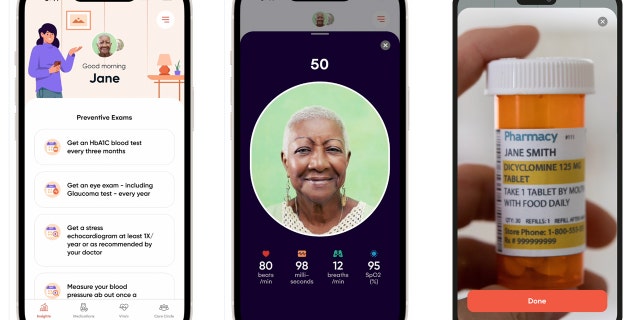
The Together app (pictured) allows people to better manage their prescriptions and monitor their vital health signs, among other tasks. (Together by Renee)
Studies have also shown that missed appointments can significantly increase the risk of “all-cause mortality,” especially among those with mental health conditions.
With Together, patients or their caregivers can take photos of their appointment cards to automatically add them to the calendar.
“We believe you should be able to see that your parents are OK, so you can rest easy at night.”
“The app might say, ‘Here’s the appointment you have coming up with your endocrinologist, so we’ll add it to the calendar for you and we’ll also share it with your daughter so she can drive you,’” Dua said as an example.
“These are all supportive ways in which the app is helping patients and their caregivers simplify routine tasks,” Dua said.
NEW AI TOOL HELPS DOCTORS STREAMLINE DOCUMENTATION AND FOCUS ON PATIENTS
Many of the people most interested in Together are adults with aging parents, such as Dua, she said.
“We are not living with our parents, but we’re worried about them,” she said. “And this allows us to share data with each other.”
She added, “We believe you should be able to see that your parents are OK, so you can rest easy at night, then wake up in the morning and start again.”
‘Not a decision-maker’
The Together app is not designed to replace traditional health care, Dua pointed out.
“It’s not a decision-maker. It’s not designed to replace the doctor’s office or a physician,” she said. “We’re not a doctor’s office, but we’re here to guide and support.”
She went on, “This is solely for guidance for patients and their caregivers, and they can share their data with whomever they want.”

As many as 55% of older adults fail to take their prescribed medications, according to data from the Department of Health and Human Services. (iStock)
When the company first launched, the founders did a pilot of the app and specifically included doctors to get their input, Dua said.
“The doctors loved it — and as a doctor myself, I can vouch for this,” she told Fox News Digital.
“Every time I see patients, I give them four things to do. And when they come back to see me in three months, they’ve only done two of the four things.”
With Together, said Dua, the software on the phone does virtually everything for patients.
“The routine tests are getting done and the results can be shared with the doctor very easily,” she said.
CLICK HERE TO SIGN UP FOR OUR HEALTH NEWSLETTER
The company is HIPAA-compliant, Dua explained, which means it doesn’t share a user’s data with anyone unless the patient has invited someone to see it.
“We take privacy very seriously,” she said. “It’s also built into the way we use artificial intelligence — everything is de-identified and is used strictly for the purpose of support.”
Additional features later this year
Together is currently available for free for Apple smartphones on the Apple App Store and will soon be available for Android smartphones on the Google Play Store, according to a company press release.
The company is also planning to roll out additional features for the app later this year.
Soon, users will be able to submit a picture of their insurance card to instantly see their plan’s benefits, or upload patient intake forms and share them with their doctors.
The AI will also be able to measure stress and anxiety through voice monitoring — and call a doctor or pharmacy for refills.

Health
Introducing Our Product Reviews Team, and How We Review | Woman's World

Sign Up
Create a free account to access exclusive content, play games, solve puzzles, test your pop-culture knowledge and receive special offers.
Already have an account? Login
Forgot your password?
Get back to the Sign In
Use left and right arrow keys to navigate between menu items.
Use escape to exit the menu.
Health
What You Should Know About the Military Diet: Experts Weigh In | Woman's World

Sign Up
Create a free account to access exclusive content, play games, solve puzzles, test your pop-culture knowledge and receive special offers.
Already have an account? Login
Forgot your password?
Get back to the Sign In
Use left and right arrow keys to navigate between menu items.
Use escape to exit the menu.
Health
Could your car make you sick? Study highlights potentially cancerous toxins in vehicles
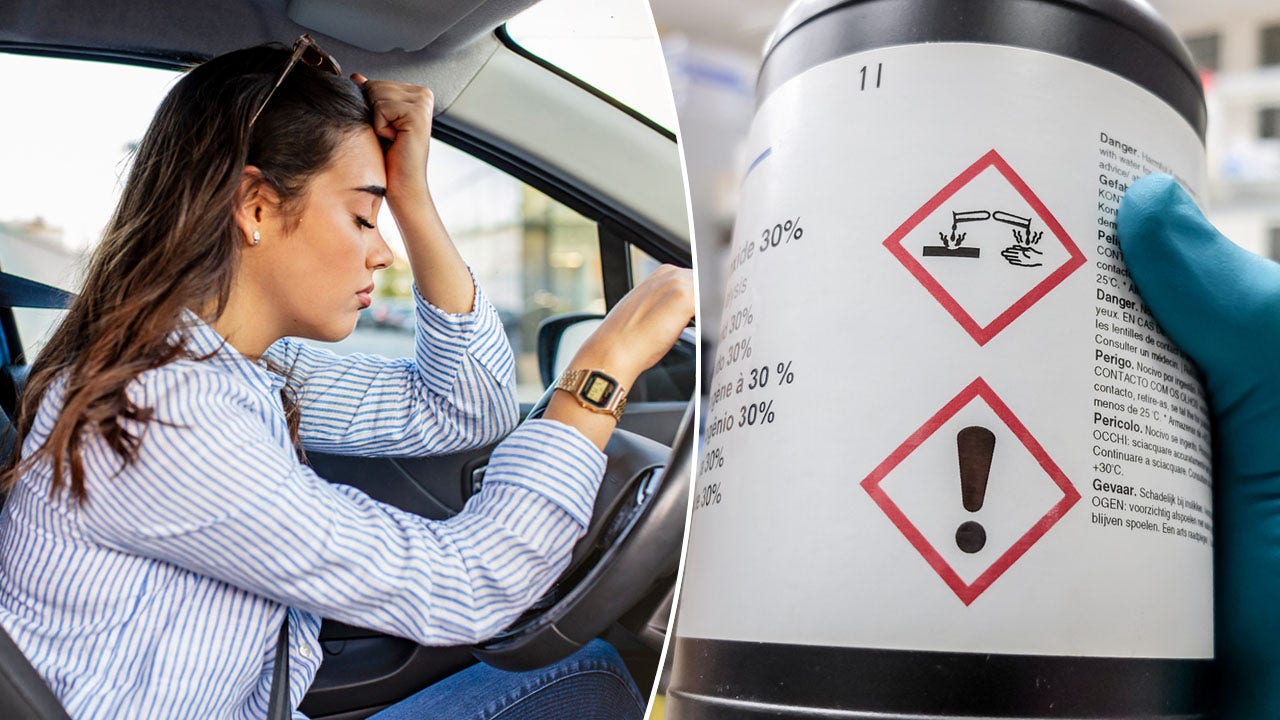
Americans may be breathing in cancer-causing chemicals while driving, recent research suggests.
A study published in the journal Environmental Science & Technology has sparked discussions about the potentially harmful toxins that could be lurking in the cabins of vehicles.
“Certainly the indoor air quality can cause health symptoms,” Dr. Ken Speath, M.D., the division chief and medical director for occupational and environmental medicine at Northwell Health on Long Island, New York, told Fox News Digital.
‘FOREVER CHEMICALS’ FOUND IN US DRINKING WATER, MAP SHOWS ‘HOT SPOTS’ OF HIGHEST LEVELS
It is important to be mindful of what you’re breathing in at home, at the office, at school and even in cars, according to Speath, who was not involved in the study.
“There can be situations where levels of harmful chemicals get high enough to potentially cause health harms,” he said.
Americans may be breathing in cancer-causing chemicals while they are driving, recent research suggests. A study published in the journal Environmental Science & Technology has sparked many discussions. (iStock)
“A car is a closed small space — so whatever is in the air is certainly going to be breathed in.”
Research reveals ‘harmful chemicals’
The peer-reviewed study looked at 101 owned vehicles in the U.S., model year 2015 or newer.
The researchers concluded that harmful flame-retardant chemicals — including those suspected of potentially causing cancer and some neurological issues — may be polluting the air inside vehicles.
DRIVING DANGERS: 9 TOP DISTRACTIONS THAT CONTRIBUTE TO ACCIDENTS, ACCORDING TO EXPERTS
“Flame retardant chemicals, which are intentionally added to vehicle interiors to meet flammability standards, are released into the cabin air from the materials to which they were applied,” lead author Rebecca Hoehn, a scientist at Duke University, told Fox News Digital.
“People in these vehicles may be exposed to these chemicals.”
Seat foam was the only material the researchers measured, Hoehn said, but other interior materials could also contain the chemicals.

The researchers concluded that harmful flame-retardant chemicals — including those suspected of potentially causing cancer and some neurological issues — may be polluting the air inside vehicles. (iStock)
“Considering the average driver spends about an hour in the car every day, this is a significant public health issue,” Hoehn warned.
“It’s particularly concerning for drivers with longer commutes, as well as child passengers, who breathe more air pound for pound than adults.”
The chemicals detected in the car cabins included a flame retardant called tris (1-chloro-isopropyl) phosphate (TCIPP), which is currently being investigated as a potential carcinogen by the U.S. National Toxicology Program.
“Considering the average driver spends about an hour in the car every day, this is a significant public health issue.”
Other flame retardants — tris (1, 3-dichloro-2-propyl) phosphate (TDCIPP) and tris (2-chloroethyl) phosphate (TCEP) — were also detected.
These are “two Californian Proposition 65 carcinogens linked to neurological and reproductive harms,” according to a press release.
Higher concentrations of the flame retardants were found during warmer weather.
“We found that the same cars, sampled in both winter and summer, had higher concentrations of flame retardants in the cabin air during the warm summer months,” Hoehn told Fox News Digital.

Flame retardants are added to vehicles to meet the National Highway Traffic Safety Administration Federal Motor Vehicle Safety Standard, which mandated their use in the 1970s. (iStock)
Flame retardants are added to vehicles to meet the National Highway Traffic Safety Administration Federal Motor Vehicle Safety Standard (FMVSS 302), which mandated their use in the 1970s, the release stated.
Flame retardants have been the “focus of concern for some time,” Speath told Fox News Digital.
More information is needed to determine the health risks these chemicals pose in humans, he said.
THESE MEDICATIONS COULD MAKE DRIVING DANGEROUS, THE FDA WARNS
“A number of these have been demonstrated in studies to have health harms in animals,” he said.
“That doesn’t necessarily mean that would be true for humans, but it raises that possibility, so we need to study these chemicals more in relation to their effects on humans.”
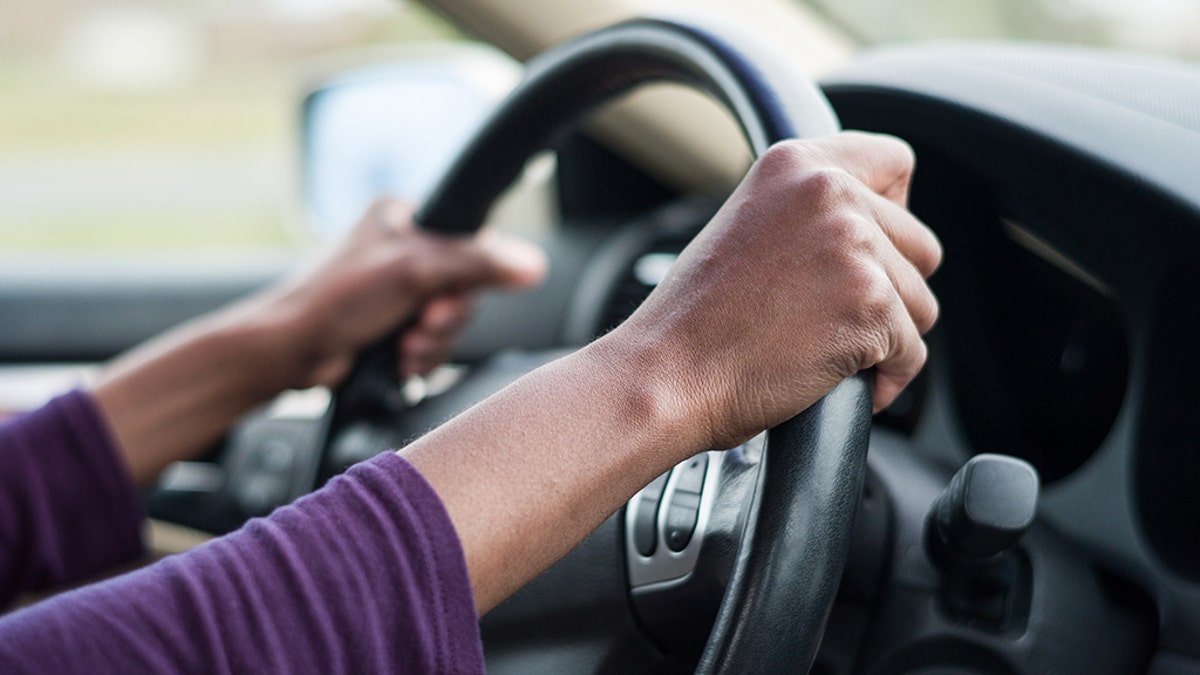
Higher concentrations of the flame retardants were found during warmer weather, the researchers said. (iStock)
Emanuela Taioli, M.D., PhD, the director of the Institute for Translational Epidemiology at Icahn School of Medicine at Mount Sinai in New York City, was also not part of the study, but shared her reactions.
“This is a very relevant finding, since it may prompt changes in cars’ upholstery, as well as in other parts of the car where there is foam,” she told Fox News Digital via email.
“We also want to know more about this finding and monitor whether it is replicated by other investigators.”
Other sources of toxins
Stephen Showalter, a home inspector and indoor environmental air consultant with Showalter Property Consultants in Maryland, said he typically interviews clients about their history of illness, then tests for potential sources of sickness in buildings, cars, RVs and boats.
Mold is a common culprit when it comes to health issues triggered by one’s environment, he said in an interview with Fox News Digital.
TOXIC CHEMICAL POISONING: HAVE YOU BEEN AFFECTED? HOW TO KNOW
Dr. Daniel Johns, a member of the International Society of Environmentally Acquired Illnesses and a chiropractor who practices in Annapolis, Maryland, echoed Showalter’s concerns about mold-related health issues.
Johns also cautioned that cars can be a daily source of mold exposure.
“Any water that leaks from a window, sunroof or convertible can get into the carpet and cause mold growth,” he said during an interview with Fox News Digital.
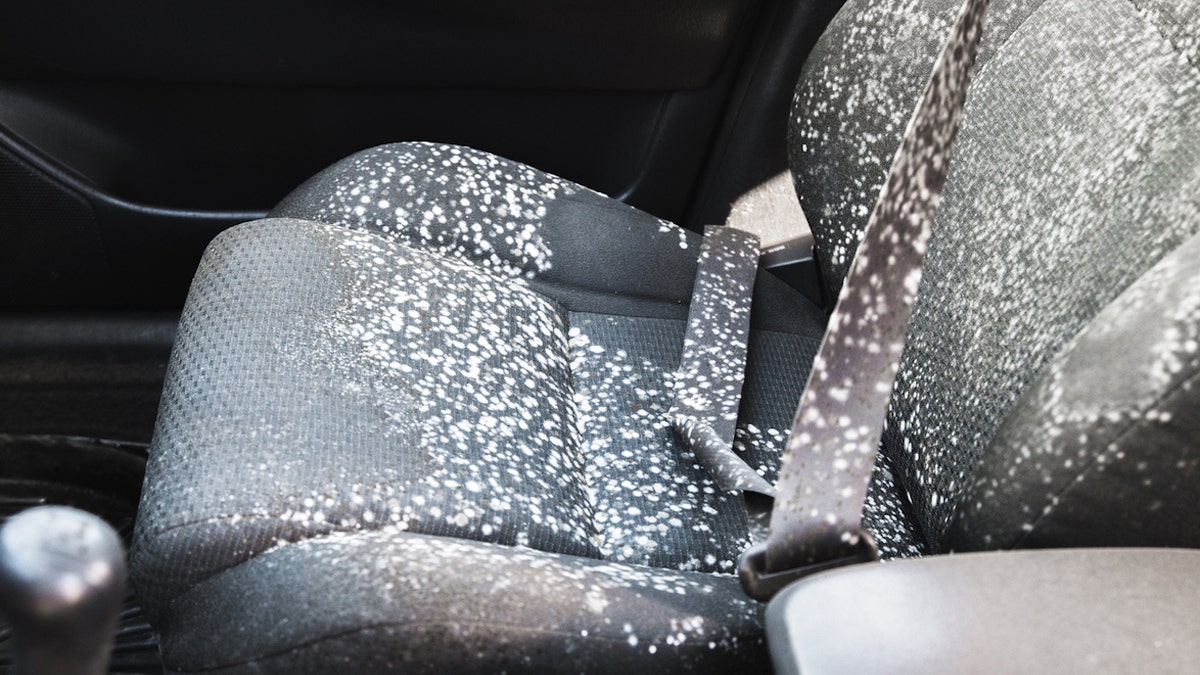
Mold is a common culprit when it comes to health issues triggered by one’s environment, according to an environmental expert. (iStock)
“Mold can start growing on a wet surface within 24 to 48 hours.”
For families with small children, spilled sippy cups could play a role when it comes to mold in cars, Johns warned.
“The water seeps into the upholstery and doesn’t get noticed or properly dried out, and the whole seat can become moldy,” he said.
“Mold can start growing on a wet surface within 24 to 48 hours.”
“Every time you sit on the seat, it releases a mold spore cloud into the car. Once that happens, you can’t clean it away. The upholstery must be removed and replaced.”
The impact of these potentially harmful pollutants can vary from one person to the next, experts told Fox News Digital.

For families with small children, spilled sippy cups could play a role when it comes to mold in cars, an expert warned. (Kids and Car Safety)
People metabolize chemicals and toxins in different ways, according to Taioli.
“Metabolism happens through enzymes that the body produces,” he said.
“Each of us has a different genetic profile that defines our metabolic capacity. As a consequence, the same amount of toxin may be metabolized better/faster by some, and worse/slower by others.”
Tips for ensuring safe interiors
While further research on car-borne chemicals is needed, experts say people can take measures to limit exposure.
“People may be able to reduce their exposure by ventilating their cars,” Hoehn advised.
“For example, rolling down the windows to let out contaminated air, or pulling in fresh air with climate control systems, should reduce concentrations.
“Ultimately, reducing the amount of flame retardants added to vehicles in the first place would provide the greatest reduction in exposure risk.”
Controlling your vehicle’s cabin temperature may also reduce exposure, she added.
“Parking in a garage or shade instead of full sun may reduce the cabin temperature and limit the extent of flame retardant release,” Hoehn said.
The researchers also called for action from regulatory agencies and vehicle manufacturers.
CLICK HERE TO SIGN UP FOR OUR HEALTH NEWSLETTER
“Ultimately, reducing the amount of flame retardants added to vehicles in the first place would provide the greatest reduction in exposure risk,” Hoehn noted.
“If flammability standards for vehicles could be revised to meet fire safety guidelines without the use of added flame retardants, risk of flame retardant exposure from personal vehicles could be greatly reduced.”

To prevent mold in a vehicle, experts recommend keeping your windows up when it rains or snows to prevent water from permeating the carpet or fabric. (iStock)
Having your car’s air quality and surfaces tested is one way to reduce the risk of exposure to allergens, toxins and chemicals, experts told Fox News Digital.
To prevent mold in a vehicle, Showalter recommends keeping your windows up when it rains or snows to prevent water from permeating the carpet or fabric.
He also cautioned about leaky air conditioners, which can foster mold growth in vehicles, and about leaving wet items in the car.
Lastly, before buying a used car, he said it is important to check the vehicle’s history to make sure it doesn’t have flood damage, which can lead to mold and other issues.
If you think you are experiencing illness due to chemical exposure in your car, home or office, it’s best to see a health care professional to discuss your symptoms.
Fox News Digital reached out to several major car companies for comment.
For more Health articles, visit www.foxnews.com/health.
-

 Politics1 week ago
Politics1 week agoFox News Politics: No calm after the Stormy
-

 World1 week ago
World1 week agoIndia Lok Sabha election 2024 Phase 4: Who votes and what’s at stake?
-

 News1 week ago
News1 week agoSkeletal remains found almost 40 years ago identified as woman who disappeared in 1968
-

 Politics1 week ago
Politics1 week agoUS Border Patrol agents come under fire in 'use of force' while working southern border
-

 Politics1 week ago
Politics1 week agoTales from the trail: The blue states Trump eyes to turn red in November
-

 World1 week ago
World1 week agoBorrell: Spain, Ireland and others could recognise Palestine on 21 May
-

 World1 week ago
World1 week agoCatalans vote in crucial regional election for the separatist movement
-

 World1 week ago
World1 week agoEurope matters to consumers, and so does your vote














